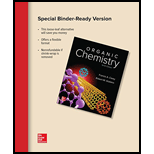
Loose Leaf for Organic Chemistry
10th Edition
ISBN: 9781259626548
Author: Francis A Carey Dr., Robert M. Giuliano
Publisher: McGraw-Hill Education (edition 10)
expand_more
expand_more
format_list_bulleted
Question
Chapter 19, Problem 26P
Interpretation Introduction
Interpretation:
The final product with a molecular formula
Concept introduction:
Thionyl chloride
Lithium aluminum hydride is a strong reducing agent. The reduction of a carboxylic acid by
Oxidation reaction involves an increase in the
Reduction reaction involves a decrease in the
Expert Solution & Answer
Want to see the full answer?
Check out a sample textbook solution
Students have asked these similar questions
Predict the products of the following reactions.
(a) benzyl bromide + sodium cyanide
(b) product of (a) + cyclopentylmagnesium bromide, then acidic hydrolysis
(c) product of (a) + DIBAL-H, then hydrolysis
A certain hydrocarbon, C5H6, yields the two products shown below upon ozonolysis with 1. O3/CH2Cl2 2. Zn/H3O . Deduce the structure of the hydrocarbon.
A synthetic organic molecule, G, which contains both aldehyde and ether functional groups, is subjected to a series of reactions in a multi-step synthesis pathway. In the first step, G undergoes a Wittig reaction, leading to the formation of an alkene, H. Subsequently, H is treated with an ozone (O3) reagent followed by a reducing agent in an ozonolysis reaction, resulting in the formation of two different products, I and J. Considering the functional groups present in G and the nature of the reactions involved, what are the most probable structures or functional groups present in products I and J? A. I contains a carboxylic acid group, and J contains an aldehyde group. B. I contains a ketone group, and J contains an alcohol group. C. I and J both contain aldehyde groups. D. I contains an ester group, and J contains a ketone group. Don't use chat gpt.
Chapter 19 Solutions
Loose Leaf for Organic Chemistry
Ch. 19.1 - Prob. 1PCh. 19.4 - Prob. 2PCh. 19.5 - Prob. 3PCh. 19.6 - Problem 19.6 What is the most acidic neutral...Ch. 19.7 - Problem 19.6 Write an ionic equation for the...Ch. 19.9 - Prob. 6PCh. 19.11 - Prob. 7PCh. 19.12 - Prob. 8PCh. 19.14 - Prob. 9PCh. 19.15 - Prob. 10P
Ch. 19.16 - Prob. 11PCh. 19.16 - Prob. 12PCh. 19 - Prob. 13PCh. 19 - Prob. 14PCh. 19 - Prob. 15PCh. 19 - Prob. 16PCh. 19 - Show how butanoic acid may be converted to each of...Ch. 19 - Show by a series of equations how could synthesize...Ch. 19 - Prob. 19PCh. 19 - Prob. 20PCh. 19 - Prob. 21PCh. 19 - Give the product of the reaction of pentanoic acid...Ch. 19 - Prob. 23PCh. 19 - Prob. 24PCh. 19 - Each of the follwing reactions has been reported...Ch. 19 - Prob. 26PCh. 19 - Prob. 27PCh. 19 - Prob. 28PCh. 19 - Prob. 29PCh. 19 - Prob. 30PCh. 19 - The 1H NMR spectra of formic acid (HCO2H), maleic...Ch. 19 - Prob. 32PCh. 19 - Prob. 33PCh. 19 - Prob. 34DSPCh. 19 - Prob. 35DSPCh. 19 - Lactonization Methods In Section we saw that...Ch. 19 - Prob. 37DSP
Knowledge Booster
Similar questions
- Cyclohexene can be converted to 1-cyclopentenecarbaldehyde by the following series of reactions. Propose a structural formula for each intermediate compound.arrow_forwardWhen A is reacted with hot aqueous NaOH, a compound B of molecular formula C8H11NO is produced. With this information, write the correct structure of B and propose the reaction mechanism (step by step, with the correct use of arrows) to obtain B.arrow_forwardWhen the compound shown below undergoes acid-catalyzed dehydration, a ring expansionoccurs to give the fused-ring product. What type of intermediate is formed in this reaction?Explain the ring expansion in terms of the reaction mechanismarrow_forward
- The following reaction was performed as part of a research program sponsored by the National Institutes of Health to develop therapeutic agents for the treatment of cocaine addiction. Using what you have seen about the reactions of halogens with alkenes, propose a mechanism for this process.arrow_forwardAmines are converted into alkenes by a two-step process called Hofmann elimination. SN2 reaction of the amine with an excess of CH3I in the first step yields an intermediate that undergoes E2 reaction when treated with silver oxide as base. Pentylamine, for example, yields 1-pentene. Propose a structure for the intermediate, and explain why it readily undergoes elimination.arrow_forwardThree products with the molecular formula C6 H4BrCl form when bromobenzene is treated with chlorine, Cl2, in the presence of FeCl3 as a catalyst. Name and draw a structural formula for each product.arrow_forward
- Provide the reagent and mechanism for the transformation below. Explain in detail how the reaction conditions provide the given regioselectivity observed in the product.arrow_forwardCompound A has the formula C9H19Cl. B is a C9H19Br compound.A and B undergo base-promoted E2 elimination to give the same alkene C as the major product as well as different minor products.C reacts with one molar equivalent of hydrogen in the presence of a palladium catalyst to form 2,6-dimethylheptane.Addition of HCl to C yields A as the major product.Propose structures for A and B.arrow_forwardPredict the expected product for each reaction and provide IUPAC name for the correct starting material to yield the desired epoxide:arrow_forward
arrow_back_ios
SEE MORE QUESTIONS
arrow_forward_ios
Recommended textbooks for you
 Organic ChemistryChemistryISBN:9781305580350Author:William H. Brown, Brent L. Iverson, Eric Anslyn, Christopher S. FootePublisher:Cengage Learning
Organic ChemistryChemistryISBN:9781305580350Author:William H. Brown, Brent L. Iverson, Eric Anslyn, Christopher S. FootePublisher:Cengage Learning EBK A SMALL SCALE APPROACH TO ORGANIC LChemistryISBN:9781305446021Author:LampmanPublisher:CENGAGE LEARNING - CONSIGNMENT
EBK A SMALL SCALE APPROACH TO ORGANIC LChemistryISBN:9781305446021Author:LampmanPublisher:CENGAGE LEARNING - CONSIGNMENT

Organic Chemistry
Chemistry
ISBN:9781305580350
Author:William H. Brown, Brent L. Iverson, Eric Anslyn, Christopher S. Foote
Publisher:Cengage Learning

EBK A SMALL SCALE APPROACH TO ORGANIC L
Chemistry
ISBN:9781305446021
Author:Lampman
Publisher:CENGAGE LEARNING - CONSIGNMENT
